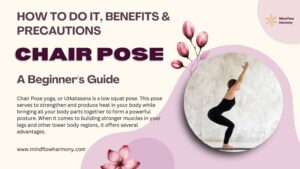Benefits of Kundalini Yoga: You may be wondering what Kundalini Yoga is all about. I’ll take you on an overview of its beginnings, history, concepts, and procedures, as well as the great advantages that come with the practice, in this blog.
What Is Kundalini Yoga?
Kundalini Yoga is used to bring out a hidden spiritual power that is “kundalini” inside all of us. Through different breathing exercises, chants, and poses, people, work to open their “energy pathways” and improve their physical, mental, and spiritual well-being.
This unique practice focuses on working with subtle energy within the body, as well as on exploring the more physical aspects of yoga like postures and breathing. It combines ancient Vedic wisdom with creative intelligence and has been practised for thousands of years in India.
In recent times, Kundalini Yoga, an ancient practice, has gained recognition and popularity for its powerful results. It is a great opportunity for people of all yoga skill levels, whether they are new to yoga or experienced. Taking the time to learn about Kundalini Yoga can help enhance one’s practice and knowledge.
History and Origins of Kundalini Yoga
Kundalini Yoga is an ancient form of yoga, and its origin can be traced back to the Vedic period in India. It has been practiced for centuries and is known as the yoga of awareness. The practice combines breathwork, postures, and meditation to help attain union with the divine.

The purpose of Kundalini Yoga is to activate the Kundalini energy, which is located at the base of the spine, and to transfer it upward through the chakras.
Kundalini Yoga combines postures (asanas) with specific breath work (pranayama) that stimulates energy flow throughout the body. Additionally, kriyas (sets of poses) are used to access deep states of meditation and focus on an individual’s higher purpose or creative potential. As practitioners are guided through each posture, they can use mantra chanting or breathing exercises to deepen their experience.
If you want to learn more about Kundalini Yoga pose , then you have to join our Yoga Teacher Training Course in Rishikesh
Other Yttc Course We Have
- 100 Hour Yoga Teacher Training in Rishikesh
- 200 Hour Yoga Teacher Training in Rishikesh
- Yin Yoga Teacher Training in Rishikesh
Also Read- Elevate Your Career: The Ultimate Guide to Yoga Teacher Training After 12th
Basic Principles and Techniques of Kundalini Yoga
Kundalini yoga is a powerful practice that can help you access your true inner power. This practice is about releasing and activating special energy inside us. We do this by doing certain poses, breathing exercises, and meditations. This energy starts at the base of the spine and goes up to the top of the head.

To understand this practice better, let’s explore the basics of Kundalini yoga and its techniques.
What is Kundalini?
Kundalini or “serpent power” is a form of energy believed to be stored at the base of the spine. According to yogic beliefs, awakening this energy through regular practice can lead to spiritual enlightenment. The purpose of Kundalini yoga is to awaken and balance this energy within your body.
Basic Principles
The basic principles of Kundalini yoga are rooted in the teachings of Yogi Bhajan, who popularized this practice during the 1960s. It combines breathing techniques, physical exercises, meditation, and chanting mantras to awaken the energy within your body. The aim is to improve your mental, physical, and spiritual well-being by unlocking the potential stored within your subtle body.
The basic principles of Kundalini Yoga include:
- Prana and Shakti: Kundalini Yoga recognizes the importance of prana, or life force energy, in the body. This energy is seen as the fuel that activates the Kundalini energy. Shakti is the feminine energy of creation, and it is believed to reside in the base of the spine.
- Breath: Breathwork is an essential aspect of Kundalini Yoga, and various breathing techniques are used to help activate and move the Kundalini energy.
- Chakras: Kundalini Yoga recognizes the seven chakras, or energy centres, in the body. The Kundalini energy is believed to rise through these energy centres as it moves up the spine.
- Mantras: Mantras are sacred sounds or phrases that are chanted or repeated during Kundalini Yoga practice. They are believed to have a powerful effect on the mind and body, and they help to focus the mind and connect with the divine.
- Meditation: Kundalini Yoga includes various forms of meditation, including mantra meditation, breath meditation, and visualization meditation.
Techniques Used
Kundalini yoga focuses on three primary techniques: asanas (postures), pranayama (breath work), and meditation. Asanas are carried out while combining specific breathing patterns with hand gestures called mudras and repeated mantras or chants known as kriyas. The combination of these three elements helps to build up the energy in the body and bring about inner transformation.
Let’s know how these Kundalini yoga techniques benefit our well-being.
- Asanas: Kundalini Yoga includes a variety of physical postures, called asanas, that are designed to activate and move the Kundalini energy. These postures are often combined with breathwork and meditation.
- Kriyas: Kriyas are specific sequences of movements, breathwork, and meditation that are designed to achieve a particular outcome. For example, a kriya may be designed to promote relaxation or stimulate the immune system.
- Mudras: Mudras are hand gestures that are used to help channel energy in the body. They are often combined with breathwork and meditation.
- Bandhas: Bandhas are energy locks that are used to help control the flow of energy in the body. There are three primary bandhas: the root lock, the diaphragm lock, and the chin lock.
Benefits of Kundalini Yoga While Practicing
Kundalini yoga aims to improve an individual’s overall well-being. It can help you live a healthier and more fulfilling life. From reducing stress and anxiety to improving physical health and sleep quality, Kundalini yoga is a holistic practice that can help to improve all areas of your life.

Some of the benefits of Kundalini yoga include:
- Increased energy and vitality: Kundalini yoga is designed to awaken the energy within you, which can result in increased energy and vitality.
- Improved physical health: Kundalini yoga can improve physical health by reducing stress, lowering blood pressure, improving flexibility and balance, and strengthening the nervous system.
- Enhanced mental clarity: Kundalini yoga can help to quiet the mind, increase focus, and improve mental clarity.
- Reduced stress and anxiety: Kundalini yoga can help to reduce stress and anxiety by regulating the nervous system and promoting relaxation.
- Increased self-awareness and self-esteem: Kundalini yoga can help you to feel better about yourself by helping you to think more positively and to accept who you are.
- Deepened spiritual connection: Kundalini yoga is a spiritual practice that can help to deepen your connection to your inner self, the universe, and a divine force.
- Improved relationships: Kundalini yoga can help to improve relationships by promoting empathy, compassion, and emotional regulation.
- Increased creativity and intuition: Kundalini yoga can help to awaken your creativity and intuition, allowing you to access deeper levels of insight and inspiration.
- Kundalini Yoga Improves Your Sleep: The deep breathing exercises used in Kundalini yoga help to calm the mind and relax the body, making it easier to fall asleep and stay asleep throughout the night.
- Kundalini Yoga Boosts Your Immune System: The practice of Kundalini yoga helps to reduce inflammation in the body, which is a major contributor to many diseases. Additionally, the breathing techniques used in Kundalini yoga help to increase oxygenation in the body, which can boost the immune system.
The healing benefits of kundalini yoga on your mind, body and sprit
Transform Your Practice and Career with Yoga Teacher Training in Rishikesh
Common Misconceptions About Kundalini Yoga
Kundalini yoga is a spiritual practice that has gained popularity in recent years. However, there are several misconceptions about Kundalini yoga that can be misleading. Some common misconceptions about Kundalini yoga include:
Kundalini yoga is only for advanced yogis This is a common misconception, but Kundalini yoga is suitable for people of all levels, including beginners. It is important to find a teacher who can guide you through the practice safely.

- Kundalini yoga is a religion: While Kundalini yoga has spiritual roots, it is not a religion. It is a practice that can be integrated into any belief system.
- Kundalini yoga is dangerous: Like any physical or spiritual practice, there are risks involved if not practiced correctly. However, with a qualified teacher and proper guidance, Kundalini yoga is safe and can be very beneficial.
- Kundalini yoga requires chanting: Chanting is a common aspect of Kundalini yoga, but it is not required. Some Kundalini yoga classes may include chanting, but it is not essential to the practice.
- Kundalini yoga is only for women: While Kundalini yoga is popular among women, it is not exclusive to them. Men can also benefit from the practice and participate in classes.
- Kundalini Yoga is Difficult: Kundalini Yoga is designed to be accessible to all levels of practitioners. It is not a competition and the postures can be adapted to suit each individual’s abilities and needs.
Kundalini Yoga has a lot of myths attached to it, but it is still a strong type of yoga that can help anyone reach their goals. In addition, it is important to do your research and find a qualified teacher who can guide you through the practice safely and help remove any false beliefs you may have.
How to Get Started with Kundalini Yoga
Getting started with Kundalini yoga can be exciting, but it can also be overwhelming for beginners
Few tips to consider while getting started:

- Be open-minded: Kundalini yoga can be a unique and transformative practice, but it may feel unfamiliar or challenging at first. Try to approach each practice with an open mind and a willingness to learn.
- Set intentions: Before each practice, take a moment to set an intention for your practice. This can help to focus your mind and bring awareness to your goals.
- Wear comfortable clothing: Wear comfortable, loose-fitting clothing that allows for easy movement. Avoid tight or restrictive clothing that can limit your movement.
- Find a qualified teacher: It is important to find a qualified Kundalini yoga teacher who can guide you through the practice safely and effectively. Look for a teacher who is certified and experienced.
- Use appropriate equipment: You may need a yoga mat, a cushion or block for support, and a blanket for relaxation. Some Kundalini yoga classes may also use props such as gongs, singing bowls, or chimes.
- Practice regularly: Consistency is key when it comes to Kundalini yoga. Try to practice regularly, even if it’s just a few minutes a day. This can help to build momentum and deepen your practice.
Remember, Kundalini yoga is a powerful practice that can offer a wide range of benefits. With a qualified teacher, appropriate equipment, and consistent practice, you can begin to experience the transformative effects of Kundalini yoga in your life.
Conclusion
Kundalini Yoga is a powerful practice that can help you to unlock your full potential. Through its history and principles, you can begin to understand how this ancient practice can profoundly impact every aspect of your life. With its roots deeply entrenched in the Hindu and Buddhist traditions, Kundalini Yoga has the power to connect us with our higher selves and help us to unlock the secrets of ourselves and our universe.
Through this practice, we can reach levels of awareness and consciousness that will help us to grow, both personally and spiritually. By connecting with Kundalini energy, we can open up the channels of life energy, allowing us to manifest our highest potential and pursue our highest dreams.








